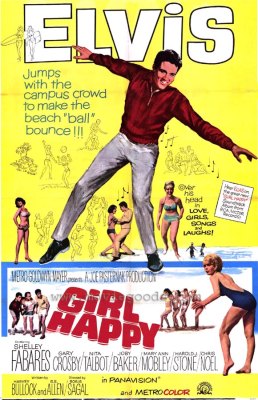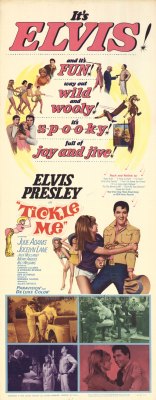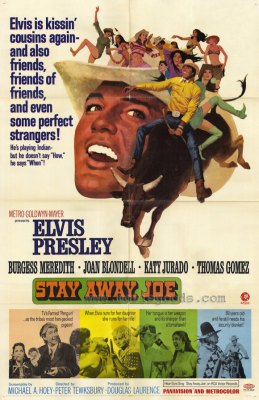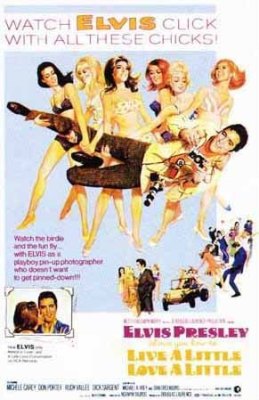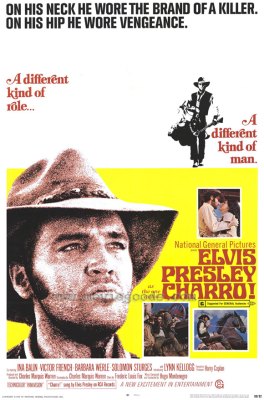| Reviews & Columns |
|
Reviews DVD TV on DVD Blu-ray 4K UHD International DVDs In Theaters Reviews by Studio Video Games Features Collector Series DVDs Easter Egg Database Interviews DVD Talk Radio Feature Articles Columns Anime Talk DVD Savant Horror DVDs The M.O.D. Squad Art House HD Talk Silent DVD
|
DVD Talk Forum |
|
|
| Resources |
|
DVD Price Search Customer Service #'s RCE Info Links |
|
Columns
|
|
|
Elvis - The Hollywood Collection (Kissin' Cousins/Girl Happy/Tickle Me/Stay Away, Joe/Live a Little, Love a Little/Charro!)
Working through the set chronologically, Kissin' Cousins (1964) is first. [Click here for Stuart's review.]
"Do the Clam, do the Clam
Grab your barefoot baby by the hand
Turn and tease, hug and squeeze
Dig right in and do the Clam!"
Girl Happy (1965)
A big step up from the lame hillbilly hijinks of Kissin' Cousins, Girl Happy is by contrast bright and sunny, if innocuous and forgettable. The earlier film had been the first in "Colonel" Tom Parker's new strategy to scale back production costs. Viva Las Vegas had been a relatively expensive undertaking, and this had sharply cut into Elvis' profit participation (and, by extension, Parker's). As a result, Kissin' Cousins was shot on a ludicrously tight 15-day schedule and a budget of less than $1.5 million, of which Elvis received more than a third up-front: $500,000. Girl Happy was made under similar circumstances, but the results aren't quite so threadbare. Produced by another Hollywood old-timer, 64-year-old Joe Pasternak, in the style of his late-career triumph, Where the Boys Are (1960), this near-remake is also rather like a classy "Beach Party" movie. The songs are pleasant if generally disposable, its bold primary colors and vacation atmosphere convey a sense of unpretentious fun and, for a change, Elvis doesn't seem totally embarrassed by the screenplay handed him.
Elvis is rock'n'roller Rusty Wells, lead man in a quartet consisting of Andy (Gary Crosby), Wilbur (Joby Baker), and Doc (Jimmy Hawkins). The band runs into trouble in Chicago where mobster and nightclub owner Big Frank (Harold J. Stone) decides to extend their engagement, even though they're already booked for their annual gig in Ft. Lauderdale. Fast-talking Elvis - er, Rusty - finds an out when Frank's daughter, Valerie (Shelley Fabares) phones to say that she and girlfriends Betsy (Chris Noel) and Laurie (Lyn Edgington) are heading to Ft. Lauderdale. Apoplectic single-father Frank, worried that his daughter will get into trouble, agrees to Elvis' idea to have him and the boys secretly chaperone Valerie.
In Florida, Rusty has the hots for Deena (Mary Ann Mobley), but after Valerie is amorously pursued by sex-starved Italian exchange student Romano (Fabrizio Mioni), Rusty ditches Deena for Valerie and, not surprisingly, the two fall for one another. But what will happen when Valerie realizes that Rusty is, in essence, working as a paid companion?
Girl Happy strikes a happy medium with Elvis' Rusty. He's neither the ready-to-brawl hothead of so many of his early films, nor is he the sickly sweet pillar of the community as generally portrayed in his post-Army pictures. Girl Happy instead offers a sanitized approximation of the real Elvis: a popular entertainer who uses his stage charisma to pick up chicks for a little no-obligation lovin' back at the motel, a guy who's all business on-stage, but who likes to go water skiing, boating and, especially, hang out with his entourage (his band) of guys similarly looking to score. Though probably amused by this G-rated portrait of Spring Break and rock band life, Elvis at least is free from the outrageously inauthentic hillbilly antics of Kissin' Cousins, and through most of the film Elvis gives an amused performance.
Mobley, a former Miss America, is miscast as relative "bad girl" Deena, but Fabares in her first of three Elvis movies is a good match. Her girl-next-door innocence is balanced with a peppy desire to cut loose and have some fun - she's no prude. And in one memorable scene, drowning her sorrows in gallons of champagne after she learns of Rusty's collusion with her father, she does an impromptu strip at an adults-only club, albeit it a wholesome MGM-imagined one.
Most of the action centers around a single massive motel courtyard set complete with swimming pool and room fronts, in retrospect an evocatively sixties bit of motel architecture. The elaborate forced-perspective design limits the choice of angles and we see far too much of the thing before the picture's over, but the filmmakers make the best of it. Conversely, none of the film was actually shot in Ft. Lauderdale except for a few stock establishing shots (reportedly footage from Where the Boys Are). As with G.I. Blues and Fun in Acapulco, there are a lot of patently phony process shots feebly trying to convince us Elvis actually went to Florida, while some of the beach exteriors - barely more than a few extras in swimwear sitting under beach umbrellas - have been beefed up with obviously phony palm trees. All this creates a curiously unreal atmosphere, a beach party movie without a beach.
Prolific TV director Boris Sagal, in his only Elvis outing, handles the film's broad comedy surprising well. The laughs may be only slightly more sophisticated than the Frankie-Annette "Beach Party" movies, but Sagal manages some surprisingly well-timed sight gags and reactions from the young cast, while character veterans like Harold J. Stone, Jackie Coogan, and John Fiedler lend their welcome experience. (Underutilized Nita Talbot has several nice bits as saucy stripper Sunny Daze.) Best of all Elvis and the boys are believable both as a band and as best buddies, and are relaxed and natural around one another.
With Beatlemania sweeping the globe and A Hard Day's Night still fresh on everyone's mind, the oddball decision was made to tweak an intended youthfulness into at least some of Elvis' vocals by slighting speeding up the playback, an effect most obvious during the not-bad title tune. He reportedly hated the songs anyway, though they're not bad, just generic. (One song, "Startin' Tonight," was cut from earlier home video versions but has been reinstated here.) The only real embarrassment here is "Do the Clam," a would-be dance craze that never materialized. That song was co-written by Dolores Fuller, Ed Wood's famous ex-girlfriend. George E. Stoll's underscoring is thuddingly literal: Elvis' bandmates are accompanied everywhere by "Three Blind Mice," while "Hush, Little Baby" is heard repeatedly during Fabares' sentimental scenes with her dad.
Tickle Me (1965)
A mismatched grafting of the usual "Elvis movie" shenanigans with a calamitously bad climax culled from myriad Three Stooges and Bowery Boys comedies, Tickle Me is a feeble mess of a movie with its star barely going through the motions.
Lonnie Beale (Elvis) is an out-of-work rodeo star who reluctantly accepts on offer from 40-ish Vera Radford (Julie Adams, still very sexy) to take care of the horses at her ranch/health spa, the Circle Z, where women from all walks of life - "actresses, models, career women" - hide out while shedding those unwanted pounds. (They disparagingly refer to it as "Yogurt Gulch.") The girls all go gaga over Lonnie, though surly swimming instructor Brad Bentley (Edward Faulkner) and calisthenics coach Pamela Meritt (Jocelyn Lane) are unimpressed, even hostile toward the new hire, a "sagebrush Lothario" as she calls him. Among his co-workers only goofy bunkmate Stanley Potter (the underrated Jack Mullaney, put to better use in Spinout) embraces Lonnie's laid-back charm. There's plenty of opportunity, as Lonnie hardly ever goes anywhere near the stables.
Lonnie eventually wins over the suspicious Pam, though they're soon on the outs again after she catches Vera trying to seduce him. Meanwhile, as Pam sulks about, mysterious crooks are after her grandfather's hidden treasure ($100,000 in gold coins), squirreled away somewhere in a nearby ghost town.
The writers of this alleged comedy were veterans Elwood Ullman and soundman-turned-director Edward Bernds (The Queen of Outer Space). They had toiled away for years in Columbia's short subject department, most notably with the Three Stooges. Beginning with Loose in London (1953), Bernds and Ullman collaborated on a batch of even lower-brow Bowery Boys comedies over at Allied Artists, including High Society (1955), the Leo Gorcey - Huntz Hall laugh riot for which Ullman and Bernds received an Academy Award nomination. No foolin'. (The nominating committee actually had made a mistake, confusing that picture with the Bing Crosby-Grace Kelly movie of the same name.) After that, the pair eventually drifted back into Stoogeville, working together or separately with the tired team on many of their kiddie-targeted feature films of the late-1950s through the mid-'60s.
Tickle Me's climax is "vintage Shemp," with Lonnie, Stanley, and Pam spending the night in the ghost town's restored but unoccupied hotel, where the bad guys dress up as monsters and try to scare them off (to what end?), peering through windows and secret panels in their wolfman masks and such. This kind of thing worked with seasoned comedians like the Stooges, but Elvis can't muster up enough energy to execute a simple double-take: he's like James Finlayson on acid.
The whole set-up for this Big Laff finish is a mess both in the writing and execution. The three meet up in the ghost town just as it begins pouring rain, this despite the fact that it's obviously broad daylight and raining only over the three actors' heads. They decide to spend the night at the lavishly appointed but inexplicably unguarded, unlocked hotel, where they immediately settle in for the night, even though it seems to be about three in the afternoon. The bad guys have guns and are after Pam's treasure map, but instead dress in Halloween costumes trying to frighten them. All of this plays out in front of flimsy sets that shudder noticeably whenever anyone bangs into a wall.
Equally bad is the film's inspired Western spoof, with Elvis the milk-swiggin' "Panhandle Kid," while the rest of the cast assume similarly broad archetypal roles. The best thing about this sequence is its merciful brevity.
The rest of the production is similarly cheap. Most of the exteriors were filmed on obvious, badly-lit soundstage sets with painted backdrops where the "sun" creates multiple shadows on the soundstage floor. Late in the picture Lonnie returns to the rodeo, and the matching of the stock footage bronco-busting with close-ups of Elvis is truly pathetic and utterly unconvincing on any level.
The cut-rate nature of the picture seeped into its soundtrack. None of the songs are original to the movie. All nine had been sitting on the shelf going as far back as 1960. This wasn't necessarily a bad thing, as the music written especially for most of Elvis' films during this period were pretty bad anyway. This collection sounds even older than it was, harking back as it does to Presley's pre-army days, though the mixing and its emphasis on echo effects only adds to the unreality of this bit of cost-cutting. The songs even fade out at the end, like 45rpm singles.
Besides Adams and Mullaney, a few of the actors work hard to make this a bit more palatable. Allison Hayes, former 50 Ft. Woman, turns up at the beginning in an unconvincing blonde wig while Red West, a pal of Elvis's, plays her jealous boyfriend and he Lonnie get into a spirited if unconvincing fisticuffs. The barroom brawls (always incorporating Presley's passion for karate) seem to have been a contractual requirement; almost every Elvis movie has at least one.
Stay Away, Joe (1968)
This is Elvis' worst movie by far. Kissin' Cousins, Tickle Me and, for that matter, 1967's Easy Come, Easy Go are all quite bad; Charro! and The Trouble with Girls are feeble attempts to retool Presley's screen image; and the film often regarded as his worst, Change of Habit (1969) is actually pretty interesting if not exactly good. But Stay Away, Joe is beyond terrible; it's so incoherent that it barely qualifies as a movie at all.
The film was intended as a satire on Native American-U.S. government relations. Joe Lightcloud (Elvis) is the rodeo star son of purebred Indian Charlie (Burgess Meredith), who lives in a shack out in the Arizona desert with Joe's stepmother, fiery Mexican-Indian half-breed Annie (Katy Jurado), and Charlie's ancient father (Thomas Gomez), an old school, deadpan Indian.
Charlie, it seems, is the Native American equivalent of Ralph Kramden, a loser whose failed schemes include drilling for oil and turning the property into a golf course. Joe, trying to help the old man, convinces civic leader Hy Slager (Henry Jones) and Congressman Morrissey (Douglas Henderson) to sponsor a cattle-breeding program on the reservation, and as the film opens Joe triumphantly returns home with a herd of cows and a single bull.
The film then grinds to a mind-numbing halt for the next thirty minutes with a big party at the Whitecloud's junkyard-like home, where other characters are (sort of) introduced. We meet Joe's pals, including Bronc (L.Q. Jones) and Bull (Buck Kartalian), and Joe's sister, Mary (Susan Trustman), who's engaged to respectable and very white Lorne Hawkins (Angus Duncan). Mostly, though, the film at this point is just one very long, nearly plotless party sequence, the kind of interminable digression that was probably great fun for the actors to shoot but agony for the audience to watch.
The party gets out of hand when, short on food, it's decided to barbeque one of the new herd. Somebody goofed: the prized bull gets eaten by mistake. Of course, this asks the audience to swallow bull of another sort, that an entire head of cattle could be slaughtered (thankfully not shown), roasted over an enormous spit, and consumed all within a matter of a few hours, a feat unlikely if not logistically impossible.
Making matters worse, Annie goes on a spending spree, trading the remainder of the herd for modern conveniences, partly so that she can impress Lorne's mother (Anne Seymour) at a planned get-together. The rest of the picture follows Joe as he schemes his way out the jam he's gotten himself in with the government, all the while bedding down with his pals' girlfriends, as well as Mamie Callahan (Quentin Dean), whose jealous mother (Joan Blondell) likewise is duped by the flirtatious Joe.
The picture is a curious mix of social satire, rowdy Western comedy a la McLintock! (1963), counterculture free-spiritedness, with a dash of Alfie incongruously tossed in. Absolutely nothing in the laugh-free film works save for Fred J. Koenekamp's (The Man from U.N.C.L.E., Patton) excellent Panavision lensing, which at least makes good use of the picturesque Arizona scenery.
And yet, awful as the film is, Elvis unexpectedly gives one of his very best performances, insofar as he's far more relaxed and naturally genial than nearly all his post-Army movies. Reportedly he had high hopes for the picture and enjoyed working with the mix of veteran character actors and younger generation performers, even if the end result was virtually unreleasable.
Some critics have accused the picture of reinforcing Native American stereotypes, the opposite of what was intended, but except for Gomez's comic relief redskin and the idea that Indians are apt to misuse federal funds, there's no a lot of ammunition for defamation groups. Partly this is due to Burgess Meredith's bizarrely eccentric Charlie Whitecloud, who comes off not so much like an authentic Indian as some sort of Cambodian hippie.
There are only two songs to speak of: the title track is a pleasant if unremarkable variation on "Greensleeves," sung over great aerial shots which, juxtaposed with the song are reminiscent of How The West Was Won. "Dominque," a song that particularly embarrassed Elvis, is an ode to a lazy bull.
"How long do you think this ridiculous situation can continue?" - Elvis as photographer Greg Nolan
Live a Little, Love a Little (1968)
In yet another attempt to reshape Elvis' screen persona, Live a Little, Love a Little offers Presley his first "adult" role in a film that harks back, not very well, to the screwball comedies of the 1930s and early '40s. Stay Away, Joe's co-writer, Michael A. Hoey (son of British character actor Dennis Hoey), teamed with novelist Dan Greenburg, whose Kiss My Firm but Pliant Lips this adapts. The results are a big improvement over Stay Away, Joe but that's not saying much.
Photographer Greg Nolan (Elvis) meets Bernice (Michele Carey) on the beach in Malibu. Accompanied by her Great Dane, Albert (reportedly played by Elvis' dog Brutus), the eccentric young woman immediately propositions Greg and when he spurns her advances she sicks the big dog on him, forcing Greg into the surf for a time. She eventually takes him back to her beachfront home, feeding him pills that put him to sleep for several days.
When he awakes, Greg learns that he's been fired from his job at the Hollywood Citizen-News (there's a lot of great footage in and around the long-defunct paper), and that Bernice has had him moved out of his apartment and in with her. Greatly annoyed, Greg eventually gets a place of his own, and to pay the bills takes on two full-time jobs simultaneously: at a Playboy-type girlie magazine run by the Hugh Hefner-esque Mike Lansdown (Don Porter in an amusing performance) and, a few floors up within the same building, at an ad agency run by Louis Penlow (Rudy Vallee, all but reprising his How to Succeed in Business... role). The rest of the picture follows Greg trying to extricate Bernice from his life while, to a lesser extent, keeping his moonlighting (daylighting?) activities from his respective bosses.
Live a Little, Love a Little is rife with screwball comedy-type dialogue, and Bernice (who goes by multiple names) is a character very much like the kooky heiresses that formerly were played by Myrna Loy and especially Claudette Colbert. Bernice's manipulative character, turning Greg's world upside-down and wreaking havoc with the ferocity of a hurricane, became fashionable in movies again for a time, as variations of this sort of thing turn up in pictures like Petulia (1968), The Sterile Cuckoo (1969) and, later, What's Up, Doc (1972).
There's a thin line with such characters, between daffily endearing and gratingly annoying, and unfortunately Bernice falls squarely in the latter category. She's like a cancer in Greg's life, psychopathically controlling everything in his life. (She also has a murky, never-defined sexual hang-up.) There's almost some chemistry between Carey and Presley, but as their character's relationship is almost entirely adversarial, romance never really enters the picture. When Greg finally falls for Bernice, the baffled audience can't help but wonder why. Dick Sargent, just prior to replacing Dick York on Bewitched, plays another of Bernice's victims, though this reviewer never could figure out the exact nature of their relationship: is he an ex-lover or ex-husband? Does he still love her, or is he trying to fob her off on Greg?
The picture has two notable musical sequences. The first is an inexplicably bizarre dream sequence, part MGM '50s-style musical number, part hallucinogenic "trip," with Elvis singing "The Edge of Reality" at one point to a man in a Great Dane costume. "A Little Less Conversation," popular again in its recently remixed version, is performed here against the backdrop of a Playboy Mansion-style party, with Elvis singing to Celeste Yarnell, a gorgeous blonde. It's a lively if too-short sequence; neither song is integrated into the narrative with any finesse.
You'll have to fight, before you're free
But how much more time can you borrow?
Charro!
Charro! (1969)
"A different kind of role...a different kind of man" declared the film's advertising and, initially at least, plans were for a very different kind of film. Eschewing the fluffy dreck that dominated Elvis's film work of the last half-decade, Charro! was to be a much darker, more violent and sexually explicit than anything Elvis had ever done before, his first straight Western since Flaming Star (1960).
At least that was how it was supposed to be. Over the years, Charro! has acquired a mini-reputation as the Elvis Movie That Might Have Been. Racy scenes in writer-director Charles Marquis Warren's screenplay (from Frederick Louis Fox's story) reportedly were toned down just before production commenced while, allegedly, some of the more graphic violence and explicitly sexual content (including a purported nude scene by co-star Ina Balin) were deleted during the editing phase, possibly to ensure a "G" rating. In any case even if all this deleted footage, if it ever existed, were reinstated it's highly doubtful it could ever lift Charro! from stillborn mediocrity. Utterly lifeless, with Elvis giving one of his very worst performances, Charro! is an unmitigated disaster.
Reformed outlaw Jess Wade (Elvis) is forced at the point of a gun to ride with his old gang out into the wilderness. Leader Vince Hackett (Victor French), kid brother Billy Roy (Solomon Sturges), and artillery expert Gunner (James B. Sikking), among others, have stolen a solid-gold "victory gun," the cannon that "fired the last shot against Maximilian" and worth $100,000. Vince frames Jess for the crime, authorities on both sides of the border are looking for him, and wanted posters are everywhere noting that Jess can be identified by a severe neck wound he received while "trying to escape." Happy to oblige the posse, Vince burns Jess with a red-hot branding iron.
Jess convinces old pal Sheriff Dan Ramsey (James Almanzar) of his innocence, but when the lawman is shot Jess takes shooter Billy Roy into custody while the ailing Dan appoints Jess deputy. Caught in the middle is saloon owner Tracey Winters (Ina Balin), who once was Vince's girl until she fell in love with Jess. The film becomes something of a fourth-rate Rio Bravo at this point, with Vince demanding his brother's release - or else he'll start blowing up the town with his cannon - while the frightened townsfolk, already unsure of Jess's role in the theft, nervously insist Billy Roy be released as well. (They do not, however, leave town. Once Vince starts blowing up everything in sight, the townsfolk sensibly stand around in the middle of the street.)
Made near the height of the Spaghetti Western craze (The Good, the Bad, and the Ugly was still in release in America while this was in production), Charro! was one of a number of tepid faux-spaghettis produced entirely in Hollywood: its title design apes myriad Euro-Westerns while the title tune - the only Elvis song in the picture - is reminiscent of Ennio Morricone's Il ritorno di Ringo, sung by Maurizio Graf for that film, while the wall-to-wall underscoring by Hugo Montenegro (who, significantly, had a hit record covering Moriconne's Good, the Bad, and the Ugly theme) abounds in Spaghetti Western cliches. There's even a scene where Gunner lights the cannon's fuse with the lit-end of his cigar.
Charles Marquis Warren, however, was no Sergio Leone, or even a Sergio Corbucci. He was a prolific, not untalented TV producer-writer-director, best known for developing the TV version of Gunsmoke and The Virginian. His handful of feature Westerns had generally been B-picture fodder starring the likes of Scott Brady, John Agar, and Jeff Morrow, and produced through 20th Century-Fox subsidiary Regal Films. Years of television work seems to have sucked him dry of any sense of visual style. Despite the use of widescreen Panavision, Charro is very much shot like a generic TV Western, and in the end more closely resembles the cheap, serviceable oaters producer A.C. Lyles was shooting over at Paramount than anything coming out of Europe. At times, the direction borders on incompetent: in one scene dance hall girl Marcie (Lynn Kellogg) is photographed so badly as to appear cross-eyed.
"As the one called Charro!" (which, in fact, no one in the film does), Elvis is almost completely inexpressive. Delivering lines as if in a trance, he always seems to be two or three beats behind everyone else, and throughout the film he looks to be in a cold, clammy sweat. In his defense, the screenplay gives him no character to play: hard-headed Jess spends most of the film pissed off that no one except for Sheriff Dan believes in his innocence, but then again Jess makes no effort to convince them otherwise. Ina Balin's exotic features belied her Brooklyn roots, but as an actress she seemed to lose her way over the years, and in Charro! she's almost as wooden as Elvis is; together they're like a pair of cigar store Indians.
The low budget (a mere $1.5 million of which $850,000, more than half, went to Elvis) precluded even the use of genre character stars like Strother Martin, Ben Johnson, or Jack Elam. Instead, the film is populated with busy TV actors like French and Sikking. They're not bad, but they lack the same Western verisimilitude as the leads' fresh-from-the-dry-cleaners wardrobe. Sturges, the son of director Preston, is outrageously over-the-top as crazed half-wit brother Billy Roy, but his performance is virtually the only one in the picture with any life in it at all.
Video & Audio
Though the movies are generally poor, the 16:9 enhanced presentations are splendiferous across the board; most look like brand-new movies, with hardly any age-related wear and no signs of damage. Only Tickle Me, in its first-ever widescreen video release falls short of near-perfection. The Color by DeLuxe appears accurate to its original theatrical version, but it tends to be brownish, particularly with regard to Jocelyn Lane's unnatural-looking hair, which resembles spun gold. At one point a couple of roast chickens look yellow-green. All-in-all however, these transfers look great. The Dolby Digital mono is good throughout. Optional English and French subtitles are included.
Extra Features
Supplements are limited to trailers and photo/original poster inserts. With the exception of Tickle Me, which is 16:9 enhanced, all the trailers are grainy 4:3 LBX affairs, probably culled from laserdisc era masters. The inserts are very good, however, and the one-sheet reproductions are nice.
Parting Thoughts
Great as the transfers are, only die-hard Elvis fans will want to collect these particular movies, among the worst Presley ever made. As a group, they're interesting failures, particularly the later ones in the way they try but never succeed to change (and change Elvis' screen persona) with the times. General audiences are much better off sticking to Presley's pre-1960 efforts, as a whole a much more interesting lot and films general audiences will still find entertaining. If you love Elvis, The Hollywood Collection is Recommended for the transfers if not the movies. Everyday DVD fans and moviegoers are advised to steer clear, however.
* Jailhouse Rock (1957), Viva Las Vegas (1964) and Elvis: That's the Way It Is (1970),
Film historian Stuart Galbraith IV's most recent essays appear in Criterion's new three-disc Seven Samurai DVD and BCI Eclipse's The Quiet Duel. His audio commentary for Invasion of Astro Monster is now available.
|
| Popular Reviews |
| Sponsored Links |
|
|
| Sponsored Links |
|
|
| Release List | Reviews | Shop | Newsletter | Forum | DVD Giveaways | Blu-Ray | Advertise |
|
Copyright 2024 DVDTalk.com All Rights Reserved. Legal Info, Privacy Policy, Terms of Use,
Manage Preferences,
Your Privacy Choices | |||||||









